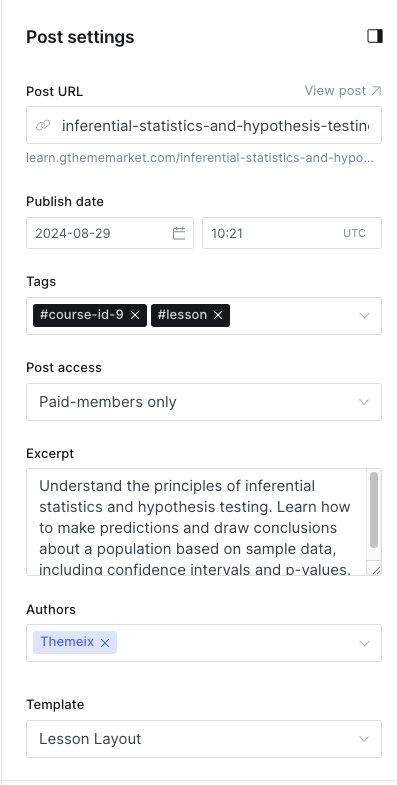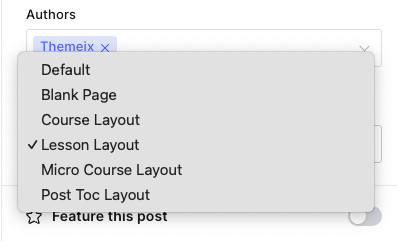Table of Contents
This guide walks you through the process of adding a lesson in Ghost CMS, covering everything from setting lesson details to managing access and tags.
01) Add Lesson Information
Important: Ensure you are creating a Post and not a Page when adding a lesson.
Start by entering the core information about your lesson:
- Title: The main name of your lesson.
- Description: Provide a clear, concise overview of what the lesson covers.
- Meta Information: Add any additional meta details necessary for SEO and organization.
Using Ghost Public Preview for Lesson Description
We recommend enabling the Ghost Public Preview feature when adding your lesson description. This option allows non-members or visitors to preview the lesson overview without full access.
Why use Ghost Public Preview?
For premium lessons, if you do not enable Public Preview, visitors won’t be able to see the course description unless they are members with access. Enabling this option makes the lesson more visible and appealing to potential students.
In our setup, we have used the Ghost Public Preview option to ensure the lesson description is visible.
02) Add Tags
Tags are essential for organizing and internal referencing of lessons and courses.
Required Internal Hashtags
Each lesson must include exactly two internal hashtags:

#course-id-X— whereXis the unique ID number for the course (e.g.,#course-id-2)#lesson— this tag is required for all course lessons
Example: #course-id-2 #lesson
Adding Public Tags and Categories
You can also add public-facing tags or lesson categories to improve discoverability and grouping.
Example: UI UX Design
Important Tagging Rules
- Always use a consistent format for course ID tags. For example:
#course-id-2,#course-id-3,#course-id-4. - Different or inconsistent formats will not work with the system.
- Public tags are allowed but must be placed after the
#lessontag.
03) Course Access Settings
Ghost CMS supports three main types of post access levels to control who can view your lesson content:
-
Public Access:
Use this setting for free lesson or lessons that everyone can view. -
Basic Membership Access:
This restricts access to users who have subscribed to the basic membership tier. It is recommended for some premium lesson. -
Premium Membership Access:
This grants access to all premium content for members who subscribe to the highest tier.
Tip: For premium lessons, always assign the correct membership tier to control who can access your content effectively.
We recommend using Basic Membership for selected premium lessons and Premium Membership for all-access passes.
04) Add Author Information
Every lesson should clearly specify the author’s name. This helps learners know who created the content and adds credibility.
05) Select Lesson Template (Layout)
Choose the appropriate Lesson Layout Template to define how the lesson content will be presented on your site.

- The template controls the visual structure, including lesson navigation, sidebar elements, and overall styling.
- Make sure to select the template designed for lesson to ensure a smooth learning experience.
Summary
- Create a Post, not a Page, to add lesson content.
- Add lesson title, description (enable Ghost Public Preview for visibility).
- Include two mandatory internal tags:
#course-id-Xand#lesson. - Add public tags/categories if desired, placing them after the internal tags.
- Set lesson access based on membership tiers (Public, Basic, Premium).
- Assign an author name to every lesson.
- Select the appropriate lesson template for consistent lesson layout.
Following these steps will help you maintain a consistent and well-organized lesson catalog on your Ghost CMS site.
If you need any assistance or have questions, feel free to reach out to your site administrator or consult the Ghost documentation.
